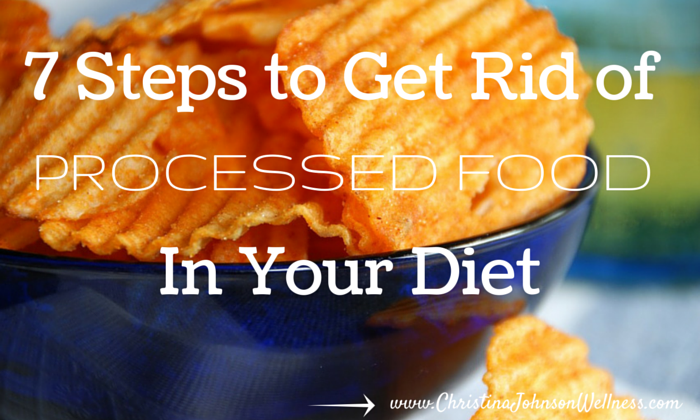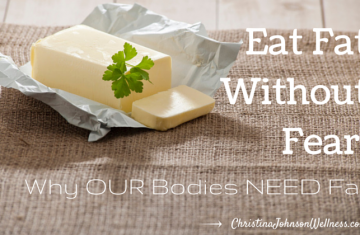Most people I talk to understand the benefits of staying away from processed food. Intuitively, I think that getting rid of processed food and eating more real foods just makes sense.
But if this is true, why aren’t more people avoiding processed foods?
My opinion? Because it seems hard! And overwhelming…and confusing…and where do you even begin?!?
To help you get past whatever feelings may be stopping you from eating more real foods and less processed foods, I have put together a list of 7 steps that will show you how to avoid processed foods without feeling overwhelmed and frustrated.
And remember, making this change is completely worth it! You will be amazed by how much easier it will be to drop those extra pounds for good, to feel confident in your body and in your clothes, and to really feel healthy.
How to Avoid Processed Foods in 7 Steps
1. Take a deep breath.
Ok, you might be surprised by this first step, but it really is important to be in the right frame of mind when beginning this journey.
Right now you may be feeling extremely excited to get rid of processed food and to start eating real food…as you should be! It’s an extremely rewarding journey that results in increased energy, weight loss, fewer aches and pains, reduced risk of disease, and the list goes on and on…
However, this may mean a huge shift in what you eat, where you eat, how you do your grocery shopping, and your cooking habits. That’s a lot of changes when you start to think about it!
Add that to the fact that the goal is to make this a lifestyle change, not simply a temporary diet change, and it can quickly become overwhelming.
So, what is my recommendation? Allow yourself to feel the excitement and enthusiasm over the upcoming journey, and then…take a deep breath.
Be honest with yourself and acknowledge that there will be some hard work and tough choices ahead. Remind yourself that it will take some time to learn what to eat and how to prepare it. Most importantly, give yourself permission to make changes gradually. The surest road to failure is feeling overwhelmed and frustrated by trying to take on too much at one time.
2. Reflect on why you really want to get rid of processed food.
Take some time, even if it’s only 5 to 10 minutes, to reflect on why you want to make the shift away from processed foods towards eating REAL food.
Ask yourself why you really want to make this change, and then be honest with yourself! If your answer is “to feel healthier”, ask yourself, “why do I really want to feel healthier?”
If your answer is “to feel more comfortable in my body and clothes”, ask yourself why you really want that.
Go deep here, be honest with yourself, and find out why you really want to start this journey.
Once you have this core reason in mind, write it down and post it in a place you will see often. Then, when you’re tempted by that donut in the morning, the bowl filled with chocolate at your co-worker’s desk, or the fast food drive-thru on your way home, remind yourself of your bigger why in order to avoid temptation.
3. Learn which foods are healthy for your body and which foods are harmful.
There are many excellent resources that can help you learn this information. I have put together a few resources to help get started:
- Read my article, The Perfect Diet, to begin understanding what it means to eat real food.
- Download my Eat REAL Foods graphic so that you know exactly which foods to eat and which to avoid.
4. Evaluate your personality type and lifestyle factors.
Some people have a personality where they want to go “all in” when they decide to make a diet or lifestyle change. They decide to throw out all of the food they shouldn’t be eating and begin to strictly follow all of the guidelines of their new diet…starting tomorrow. And other people just feel like this is how they “should” approach changing their eating habits.
I completely understand this desire to change everything at once because that’s how I (and my type A personality) tend to think. In fact, when I first transitioned away from processed food, that’s how I approached it, and (to be fair) it did work for me.
However, I had a few factors working in my favor:
- I had a highly motivating reason for wanting to make this change.
- My husband was fully supportive and willing to eat the same way as me.
- I didn’t have any kids to try to make happy at meal times.
- Although I was working full-time, I had extra time to commit to finding recipes, learning how to cook, and planning ahead.
- I already had a love of learning about health related topics.
I know, though, that not all of these factors may be true for you, which is perfectly okay!
In fact, through my work with other women, I am finding that the majority of people become easily frustrated and overwhelmed when trying to completely overhaul their diet overnight. And what usually happens when we become frustrated and overwhelmed? We give up.
I have had women tell me that they just want to go “all in” with making diet changes…unfortunately, though, for many of us who like to be “all in” we forget that there is another side to that coin, which is being “all out”. This is what causes problems for us because once we start facing challenges along the way and we start to feel like giving up, we don’t just give up quietly…instead, we go “all out”…we scarf down that whole pizza, or that tub of ice cream, or anything else we can get our hands on for the next week because we are so tired of feeling restricted and deprived.
So what is the solution to avoid this dilemma? How do we make changes so that they stick for good? By adopting a step-by-step approach that will allow you to move away from processed foods gradually over the next few weeks or even months.
Every small step you take will begin to add up and will push you closer towards your ultimate goals. Plus, each success you find will increase your motivation to continue making more changes.
So evaluate your own personality, tendencies, and lifestyle factors. I would encourage you to adopt this slow, step-by-step approach unless you know for sure that you have the time, energy, and motivation to be fully committed to going “all in”.
5. Choose your approach
Crowding Out: As you transition away from processed food, you may want to adopt a “crowding out” mentality. The idea is that you focus on adding in healthy, nutrient dense foods one at a time. When you are focused on adding in these healthy foods, you naturally begin to crowd out the unhealthy ones.
For example, you may choose to focus on drinking half your body weight in water every day. By making this your priority, you will most likely reduce how much soda, juice, and energy drinks that you are drinking. You will not only see the amazing benefits of drinking more water, but you’ll also see the benefits of drinking less sugary drinks. It’s a win-win!
Elimination: Another approach is to choose a specific food or drink that you know you want to consume less of and then gradually work towards eliminating it from your diet.
For example, let’s say that you love Oreos and eat them every day. Your goal the first week may be to only eat Oreos twice over the course of the week. Then the next week, you may only eat one Oreo, and by the last week, they are completely out of your diet.
Meal Based Approach: Another approach that works well is to focus on improving one meal or snack at a time.
As an example here, you may decide that the first week you are going to focus on eating a healthy, protein-packed breakfast every day instead of your typical cereal, bagel, or toast. Once you feel confident about eating a healthy breakfast every morning, then you might want to turn your focus towards eating a healthy afternoon snack. You can continue this process until you have fully transitioned away from processed food, one meal or snack at a time.
6. Set 1 or 2 goals.
Once you have chosen the approach you want to take, set a goal to focus on during the first week. The goal should be:
- Very specific: What exactly do you want to do?
- Measurable: How will you know you have reached your goal?
- Time-oriented: When will you begin this goal and when will you have it completed?
- Realistic: Is the goal something that you can realistically achieve in the time frame you set?
Ideally, you will only choose 1 or 2 goals each week to focus on so that you don’t overwhelm yourself.
In the beginning, choose goals that you know you will have success with. It’s important to do this in order to stay motivated to continue making changes.
If you need some help getting started, you may choose to create a goal around one of the following ideas:
- Drink half your bodyweight in water every day.
- Have 1 serving of protein with every meal.
- Eat a large salad with protein, vegetables, and a healthy fat every day.
- Avoid all processed foods at dinner time.
- Eat 1 or more servings of vegetables with every meal.
- Create a menu for a whole week so you know what you will be eating at every meal.
7. Get started!
You are now ready to start getting rid of processed food! Whatever goal(s) you set in Step #6, start working on them.
Once the week is over, re-evaluate your goals and set new ones for the next week. Repeat this process until real foods make up the bulk of your diet.
Post in the comments below what your goal is going to be for the first week!
Also, if you are highly motivated to begin making changes, but would love to have support, encouragement, guidance, and accountability along the journey, feel free to apply for a complimentary Discovery Session to find out how I can be of support to you. My journey to eating real foods took me many hours of research, trial, and error, and I would love to be able to shorten the learning curve for you!




how does cbd oil evfect ace inhibitors
Wow that was unusual. I just wrote an incredibly long comment but after I clicked submit my comment didn’t show up.
Grrrr… well I’m not writing all that over again. Anyways, just wanted to say excellent blog!